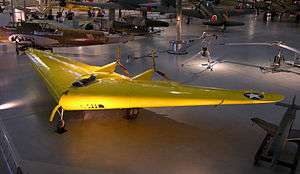Northrop N-1M
| N-1M | |
|---|---|
 | |
| Northrop N-1M on display at the National Air and Space Museum's Steven F. Udvar-Hazy Center. Restored to its final flight configuration. | |
| Role | Flying wing |
| National origin | United States |
| Manufacturer | Northrop Corporation |
| Designer | Jack Northrop |
| First flight | 3 July 1940 |
| Retired | 1945 |
| Status | Experimental |
| Number built | 1 |
| Variants | Northrop N-9M |
The Northrop N-1M, also known by the nickname "Jeep", was an American experimental aircraft used in the development of the flying wing concept by Northrop Aircraft during the 1940s.
Design and development
Jack Northrop became involved in innovative all-wing aircraft designs in the late-1920s, with his first Flying Wing being built in the 1928–1930 time period. That first prototype, the 1929 Flying Wing X-216H, evolved from earlier design studies. The X-216H had twin rudders with a single horizontal stabilizer running between them; both rudders were connected by twin booms to the thick, all-wing blended fuselage. The aircraft had an open cockpit in the center wing section and single, rear-facing, pusher propeller connected to a piston engine blended into the all-wing shape. The X-216H was first test flown in 1929 with Edward Bellande at the controls;[1] the aircraft displayed adequate performance and was noted for its unique all-metal stressed skin and multi-cellular construction. At about this same time, Jack Northrop became aware of Walter and Reimar Horten's prewar record-setting "tailless" flying wing glider designs being tested in Germany beginning in 1934.[2]
The N-1M was one of a progression of experimental aircraft that further developed Northrop's all-wing concept. The aircraft was produced in the United States and was developed during 1939 and 1940 as a flying testbed for the purpose of proving Jack Northrop's vision of a practical Flying Wing. Built mostly of specially laminated layers of glued wood, the design of both wooden wings allowed for easy configuration changes with the central blended fuselage, which was made of tubular steel. The diminutive, twin-engine test aircraft served its purpose well, first taking to the skies on 3 July 1941 at Baker Dry Lake in California.[3][N 1]
Operational history
Northrop's Chief Test Pilot Vance Breese flew the N-1M on its maiden flight, unexpectedly bouncing into the air during a planned high-speed taxi run. He reported that the aircraft could fly no higher than five feet off the ground. Flight could only be sustained by maintaining a precise angle of attack, but Theodore von Kármán solved the problem by making adjustments to the trailing edges of the elevons. Control of the aircraft was achieved through the use of a system of elevons and wingtip rudders. The elevons served in tailless type aircraft both as elevators and ailerons, while split flaps on the downward angled wingtips took the place of a conventional rudder; they were later straightened after that angle proved unnecessary during flight testing.[4]
The flight test program continued with Moye W. Stephens, Northrop Test Pilot and Secretary to the Northrop Corporation, serving as a test pilot. Early tests showed the N-1M to be satisfactory in stability and control, but overweight and underpowered. The aircraft's two 65 hp Lycoming 0-145 four-cylinder engines (buried in the wing to reduce drag) were replaced by two 120 hp six-cylinder 6AC264F2 air-cooled Franklin engines. By November 1941, after having made some 28 flights, Stephens reported that when attempting to move the N-1M about its vertical axis, the aircraft had a tendency to "Dutch roll." The oscillations proved to be manageable when adjustments were made to the aircraft's wing configuration.[4]
The N-1M proved to be basically sound, paving the way for Northrop's later and much larger Northrop YB-35 and YB-49 aircraft. The pioneering aircraft was then donated to the United States Army Air Forces in 1945 and was placed in the storage collection of the National Air Museum the following year. It sat there for nearly three decades, but was finally brought back to static, non-flying status, in its final flight configuration, after several years of painstaking restoration during the 1980s. The N-1M is now on public display at the National Air and Space Museum's Steven F. Udvar-Hazy Center.[4]
Specifications (N-1M)
Data from American X&Y Planes[4]
General characteristics
- Crew: one
- Length: 17 ft 11 in (5.46 m)
- Wingspan: 38 ft 8 in (11.79 m)
- Height: 4 ft 11 in (1.50 m)
- Wing area: 350 sq ft (33 m2) (approx)
- Gross weight: 3,900 lb (1,769 kg)
- Powerplant: 2 × Lycoming O-145 four-cylinder horizontally opposed air-cooled piston engines, 65 hp (48 kW) each (original engines)
- Powerplant: 2 × Franklin 6AC-264F2 six-cylinder air-cooled horizontally opposed piston engines, 117 hp (87 kW) each (after reengining) [5]
Performance
- Maximum speed: 200 mph (322 km/h; 174 kn)
- Range: 300 mi (261 nmi; 483 km)
- Service ceiling: 4,000 ft (1,219 m)
See also
- Related development
References
Notes
- ↑ Heavily illustrated, authoritative N-1M article.
Citations
Bibliography
- Coleman, Ted. Jack Northrop and the Flying Wing: The Real Story Behind the Stealth Bomber. New York: Paragon House, 1988. ISBN 1-55778-079-X.
- Darling, Kev. American X&Y Planes: Volume 1: Experimental Aircraft to 1945. Marlborough, UK: The Crowood Press, 2010, First edition 2009. ISBN 978-1-84797-141-8.
- Donald, David, ed. "Northrop Flying Wings". Encyclopedia of World Aircraft. Etobicoke, Ontario: Prospero Books, 1997. ISBN 1-85605-375-X.
- Maloney, Edward T. Northrop Flying Wings. Corona del Mar, California: World War II Publications, 1988. ISBN 0-915464-00-4.
- O'Leary, Michael. "Wings of Northrop, Part One". Air Classics, Volume 43, Number 12, December 2007, Challenge Publications, Inc. ISSN 0002-2241.
- Pape, Garry and John Campbell. Northrop Flying Wings: A History of Jack Northrop's Visionary Aircraft. Atglen, PA: Schiffer Publishing, Ltd., 1995. ISBN 0-88740-689-0.
- Wooldridge, E. T. Winged Wonders: The Story of the Flying Wings. Washington, D.C.: Smithsonian Institution Press, 1983. ISBN 0-87474-966-2
External links
| Wikimedia Commons has media related to Northrop N-1M. |